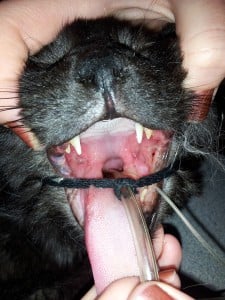What is it?
Stomatitis/pharyngitis is an inflammatory condition of the mouth. The oral tissues including the gums and tissues in the pharyngeal and faucal areas are swollen, inflamed, and painful. This disease is most common in young cats.

Causes
There may be several causes of this condition. The disease is often thought to be brought on by viral exposure, especially calicivirus. FIV and FeLV may also be underlying pre-dispositions. Tooth eruption may also cause an inflammatory response and occurs when the permanent teeth are coming in. The tooth eruption inflammation may be temporary, but severe stomatitis, especially viral induced, requires treatment.
Clinical Signs
Depending on the severity, signs and symptoms may vary. Cats may hide more or be less social. Breath often has a foul odor. Drooling, pawing at the face, and adversity to hard food can all be symptoms. Some cats may not have any obvious symptoms, which is why oral exam is so important.
Treatment
Ideally, cats affected with this condition should have routine labwork and testing for FeLV and FIV. A dental cleaning, including radiographs of tooth roots, is necessary. Teeth with fractures or resorptive lesions should be extracted.
If the dental cleaning, a long-course of antibiotics (such as clindamycin or Clavamox), tooth brushing, and oral antiseptics (chlorhexidine oral rinse) does not control the inflammation, then long term prognosis is poor and more invasive treatment may be indicated.
If the inflammation seems to be mostly around each tooth and the other treatments have failed, then extraction of all premolars and molars is indicated. The thought is that it may be auto-immune and the body is reacting to its own teeth or gum tissues. If canines are inflamed, they may also need to be extracted. The teeth should be extracted and jaws radiographed to make sure all tooth roots have been removed. Analgesia for these cats is very important and cats can benefit from some fluids and pain medication in the hospital for a couple of days following the procedure. Antibiotics should be given for 2-4 weeks until the gums have completely healed.
After radical extractions, if the disease is still present or uncontrolled, corticosteroids may be used. This is continued until the disease is in remission and then slowly reduced over a few weeks until the lowest effective dose is reached. If it is not helping, other options may include chlorambucil, cyclophosphamide, cyclosporine, interferon, or essential fatty acids.
In very severe cases in which the disease cannot be controlled and is unresponsive to these treatments, euthanasia may be necessary if it is affecting the pet's quality of life.


